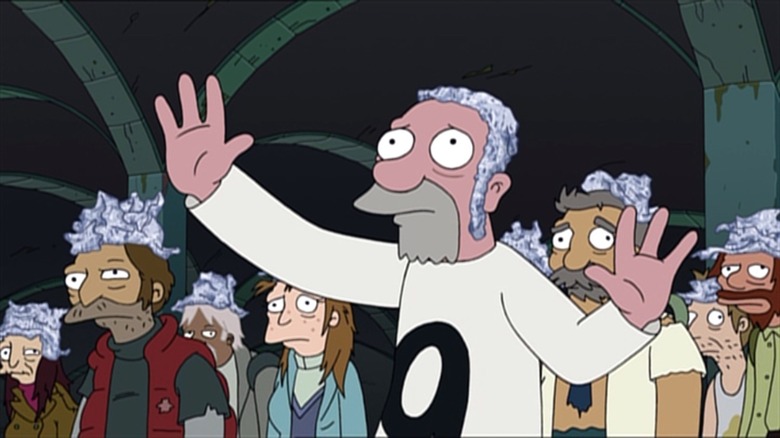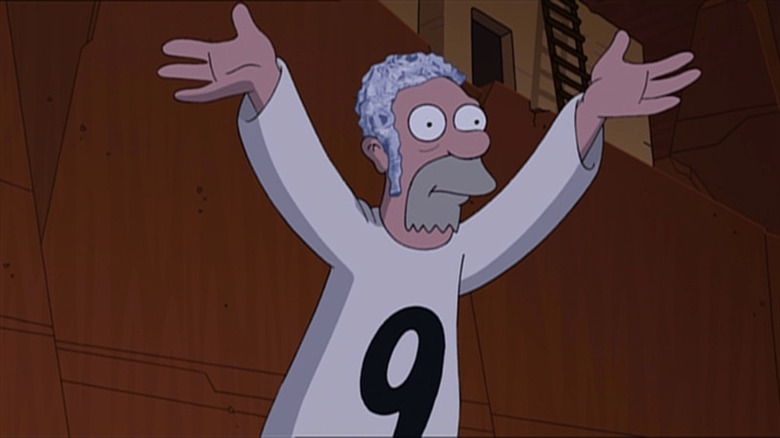Futurama's 'Number 9 Man' Is Left Over From A Much Darker Version Of The Show
Fans of "Futurama" might have noticed the Number 9 Man early on. He was a bald man with mauve skin and a grey beard wearing a long white nightshirt with the number 9 emblazoned on it. He could be seen in backgrounds and crowd scenes, yet another unusual feature in the bizarro, alien-riddled "Futurama" landscape. His number 9 was a mystery, and the character didn't have any lines or significant part to play until the 2009 "Futurama" movie "Into the Wild Green Yonder." Sci-fi fans might have posited (as this author did) that the Number 9 Man was a reference to the classic 1967 sci-fi series "The Prisoner," wherein Patrick McGoohan plays an ex-spy who was unexpectedly imprisoned in a bizarre carnival town and rechristened Number 6.
While "Futurama" co-creators David X. Cohen and Matt Groening would likely be flattered by the comparison to "The Prisoner" — they are undoubtedly fans — it seems that the Number 9 Man was a remnant left over from an earlier, and much darker, rendition of the series. While "Futurama" was still in development in the late 1990s, it was initially intended to be much more cynical. One can still see the suicide booths in certain shots. Groening once said (on a commentary track) that one of his working titles for the series was "Doomsville," implying that the series was going to be a hair more dystopian.
On a separate commentary track for the 1999 episode "A Flight to Remember," Groening noted the Number 9 Man in the background and explained to viewers and to the attendant writing staff who that was and what the 9 meant. It seems that he was once a lower rank in a dystopian class stratus, a detail left over from the "Doomsville" days.
Class-9 citizen
Groening once figured that the 31st century of "Futurama" would be a classist society, and that people would be categorized into numbered groups from one to nine. He said on the commentary traack:
"The original idea was that there was a caste system in the future and people were known by their numbers. There were different levels and mutants and sub mutants — which we ended up getting around to — but we sort of dropped the idea of gown-wearing zombie slaves."
"Gown-wearing zombie slaves" sounds like a workable story element that might be used in a more recent, single episode of "Futurama," but one has to admit that it would perhaps be a little too high-concept to include in the 1999 pilot. It seems that the designs were drawn, and the showrunners included him in background shots of eleven episodes, just to fill out the space.
Eventually, Number 9 was used often enough to be included in an actual story. In "Into the Wild Green Yonder," Number 9 introduced himself as the leader of the Legion of Mad Fellows, a loose-knit group of crazed drifters who wear tinfoil hats and scream at invisible voices. In that film, it was revealed that tinfoil-hat-wearing weirdos are actually blocking out psychic signals from everyone around them. Among the voices are a malevolent species of invisible monsters called the Dark Ones who aimed to remove life force from the universe. For "Futurama," it was all very abstract. Number 9 Man was one of the many "Futurama" characters voiced by David Herman.
And why did Groening choose the number nine? It seems it was merely because he was a Beatles fan.

